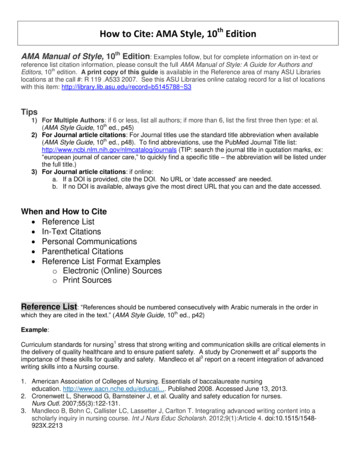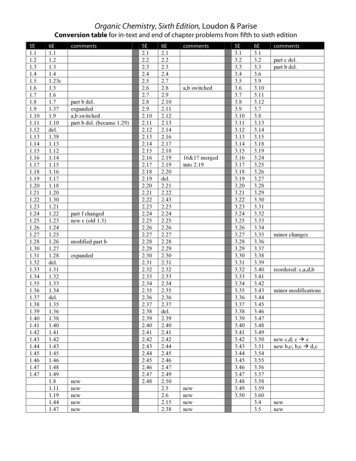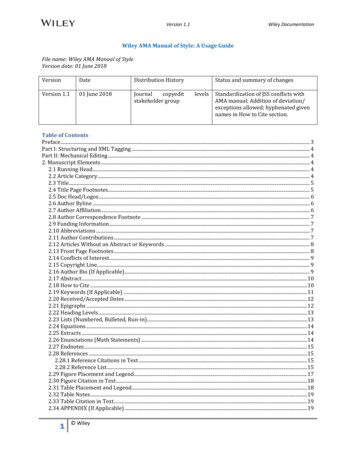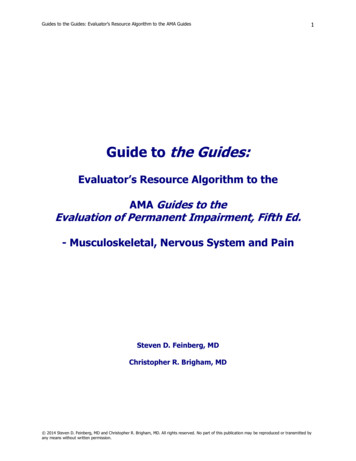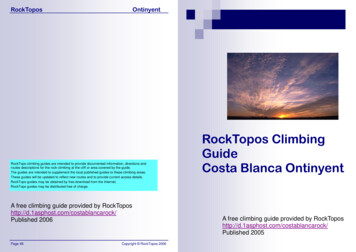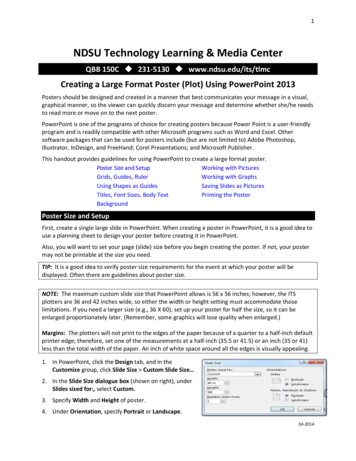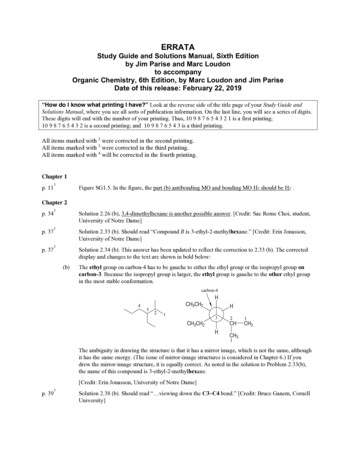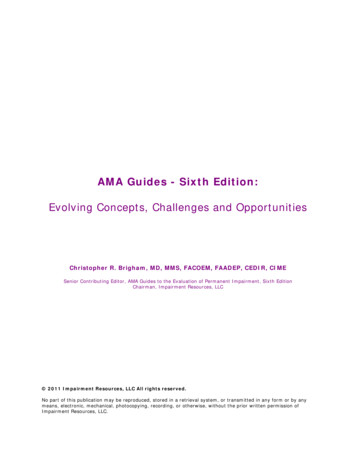
Transcription
AMA Guides - Sixth Edition:Evolving Concepts, Challenges and OpportunitiesChristopher R. Brigham, MD, MMS, FACOEM, FAADEP, CEDIR, CIMESenior Contributing Editor, AMA Guides to the Evaluation of Permanent Impairment, Sixth EditionChairman, Impairment Resources, LLC 2011 Impairment Resources, LLC All rights reserved.No part of this publication may be reproduced, stored in a retrieval system, or transmitted in any form or by anymeans, electronic, mechanical, photocopying, recording, or otherwise, without the prior written permission ofImpairment Resources, LLC.
AMA Guides Sixth Edition: Evolving Concepts, Challenges and Opportunities 2011 Impairment Resources, LLC All rights reserved.Table of ContentsLearning Objectives . 1Seminar Director . 2Orientation . 3Chapter 1 - Conceptual Foundations and Philosophy . 10Chapter 2 – Practical Applications of the Guides . 17Chapter 3 - Pain-Related Impairment . 20Chapter 15 – The Upper Extremities . 22Chapter 16 - Lower Extremities . 28Chapter 17 – Spine and Pelvis . 32Chapter 13 – Central and Peripheral Nervous System . 37Chapter 14 – Mental and Behavioral Disorders . 39Notes . 41References . 42-2-www.impairment.com
AMA Guides Sixth Edition: Evolving Concepts, Challenges and Opportunities 2011 Impairment Resources, LLC All rights reserved.Learning ObjectivesAs a result of this learning opportunity, you will be able to:1. Discuss the International Classification of Functioning, Disability and Health (ICF)and its role in impairment evaluation.2. Explain the reasons for revision of our prior approaches to impairment assessment.3. Describe how to determine Diagnosis-Based Impairments, and make adjustments onthe basis of the results of Functional History, Physical Examination, and ClinicalStudies.4. Demonstrate the ability to score Functional Inventories (including the QuickDASH,Lower Limb Outcome Scale, and Pain Disability Questionnaire).5. Explain why methods used in previous editions (such as spinal range of motionassessment and strength determination) are no longer determinates.6. Demonstrate the ability to rate most commonly rated disorders, including spinalpain, upper limb disorders (hand, wrist, elbow, shoulders and entrapments), lowerlimb disorders (foot / ankle, knee and foot), nervous system disorders, and pain.7. Discuss challenges and opportunities associated with this evolution in impairmentassessment.-1-www.impairment.com
AMA Guides Sixth Edition: Evolving Concepts, Challenges and Opportunities 2011 Impairment Resources, LLC All rights reserved.Seminar DirectorChristopher R. Brigham, MD is the Chairman of Impairment Resources, LLC. Heis the Senior Contributing Editor for the AMA Guides to the Evaluation ofPermanent Impairment, Sixth Edition, and was a contributor/author for severalchapters, including Upper Extremities, Lower Extremities, and Spine. With theFifth Edition, he served on the Advisory Committee and as a contributor. Dr.Brigham is Board-Certified in Occupational Medicine (ABPM), Founding Directorof the American Board of Independent Medical Examiners (ABIME), Master Fellow, Academyof Independent Medical Examiners of Hawaii (AIMEH), a Fellow of the American College ofOccupational Environmental Medicine (FACOEM), a Fellow of the American Academy ofDisability Evaluating Physicians (FAADEP) with Certification in Evaluation of Disability andImpairment Rating (CEDIR), a Certified Independent Medical Examiner (CIME), a CertifiedImpairment Rater (CIR), and a graduate of the Washington University School of Medicine –St. Louis. He is the Editor of the AMA publications, The Guides Newsletter and The GuidesCasebook. He was co-author of the text Understanding the AMA Guides in Workers’Compensation, Third Edition, has written over two hundred published articles on impairmentand disability evaluation and other texts, chaired the Medical Advisory Board for the MedicalDisability Advisor, Fourth Edition, is featured in several video, audio, and web-basedproductions in the medicolegal field, and has trained thousands of physicians, attorneys,claims professionals, and fact-finders, throughout the US, Canada, and internationally. He isan experienced professional speaker. As a clinician with over thirty years experience, he hasperformed several thousand independent medical and impairment evaluations, providinghim with excellent insight to the complexities of human potential, impairment, anddisability. As a result of this experience, he has consulted for numerous organizations(including governmental jurisdictions). His curriculum vitae is available athttp://www.impairment.com/PDFFiles/BrighamC CV.pdf-2-www.impairment.com
AMA Guides Sixth Edition: Evolving Concepts, Challenges and Opportunities 2011 Impairment Resources, LLC All rights reserved.OrientationThe American Medical Association’s Guides to the Evaluation of Permanent Impairment serves asthe standard for defining impairment in most workers’ compensation, motor vehiclecasualty and personal injury cases. The Sixth Edition1, published in December 2007, introducesnew approaches to rating impairment, using innovative methodology to enhance the relevancy ofimpairment ratings, improve internal consistency, promote greater precision and simplify the ratingprocess. The approach is based on a modification of the conceptual framework of the InternationalClassification of Functioning, Disability, and Health (ICF),2 although the fundamental principles underlyingthe Guides remain unchanged. To appreciate the impact of the Sixth Edition, it is useful to understand the historyand structure of the Guides, previous criticisms, and the new approaches used in the Sixth Edition. Case examplesillustrate the appropriate application of the Sixth Edition.Use of the GuidesThe AMA Guides to the Evaluation of Permanent Impairment is the basis for defining impairment in the vastmajority of workers’ compensation jurisdictions, and the use of the most recent Edition will be requiredimmediately by certain state jurisdictions and for Federal and Longshore and Harbor Workers’ Act cases.The Guides started in 1958 with publication by the AmericanMedical Association (AMA) of the article, “A Guide to the Evaluationof Permanent Impairment of the Extremities and Back”3; this wasfollowed by additional guides published in the Journal of theAmerican Medical Association. In 1971 a compendium of 13 guidesbecame the First Edition.4 The Second Edition5 was publishedthirteen years later in 1984, with publication of the Third Edition6 in1988. The Third Edition was the first to use the Swansonmethodology7 which assigned discreet impairment ratings to specificrange of motion (ROM) deficits of the upper extremities. Althoughthe Third Edition was replaced two years later by the Third Edition,Revised8, which is still used by the State of Colorado for workerscompensation cases, the use of ROM “pie charts” to assessimpairment from upper extremity ROM deficits was retained.The Fourth Edition9, published in 1993, provided many refinements, including the Diagnosis- RelatedEstimates (DRE) or “injury” model for the evaluation of spinal injuries, alternative approaches toassessing lower extremity impairment, and a pain chapter. The DRE model was unique in allowing forassignment of an impairment rating based solely on the diagnosis, even if MMI had not yet beenreached. The Fourth Edition is still used for assessing workers compensation cases in Alabama,Arkansas, Kansas, Maine, Maryland, South Dakota, Texas, and West Virginia.The Fifth Edition10, published in 2000, was nearly twice the size of its predecessor, provided moredetailed directives in all chapters, and modified the approaches used for spinal impairment evaluationby providing guidance on choice of the rating method and providing ranges for Diagnosis-RelatedEstimates (DRE) categories. The Fifth Edition is used in California, Delaware, Georgia, Hawaii, Idaho,Iowa, Kentucky, Nevada, New Hampshire, North Dakota, Ohio, Vermont and Washington.The Sixth Edition represents this continued evolution in impairment evaluation. Many states requirethe use of the “most recent Edition” of the Guides either by statute or code; States using the SixthEdition are Alaska, Arizona, Connecticut, Indiana, Louisiana, Massachusetts, Mississippi, Montana, NewMexico, Oklahoma, Pennsylvania, Rhode Island, Tennessee and Wyoming11. The most recent edition isalso expected to remain the standard for automobile casualty and personal injury cases, bothdomestically and internationally. Some of the countries abroad that use the Guides include Australia,Canada, Hong Kong, Korea, New Zealand, and South Africa.-3-www.impairment.com
AMA Guides Sixth Edition: Evolving Concepts, Challenges and Opportunities 2011 Impairment Resources, LLC All rights reserved.The Sixth Edition is the new standard for all other cases. Federal workers' compensation laws cover all federalemployees (including postal workers) and citizens of Washington, DC. Federal systems include Federal Employees’Compensation Act (FECA), Energy Employees Occupational Illness Compensation Program Act, and Longshore andHarbor Workers’ Compensation Act (LHWCA). Under the Federal Employees’ Compensation Act (FECA 5 USC 8107)benefit is given for permanent impairment to specific body parts including extremities, hearing, vision, and loss ofspecific organs. Under the Longshore and Harbor Workers’ Compensation Act ratings are performed for “scheduledinjuries” (e.g., a scheduled member of the body defined by section 8(c)(1)-(20) of the LHWCA).12 This includesupper extremity injuries (with the exception of the shoulder), lower extremity injuries, and hearing loss.The Guides are often used to quantify the extent of injuries resulting from an automobile casualty or personalinjury. Insurers may use an impairment rating as one of the factors in determining the reserve or settlement valueof a claim. Insurers and attorneys may use this as factor considered in quantifying the impact of an injury and theassociated case value. In some states, suits under no-fault automobile insurance are limited to cases where aspecific defined impairment threshold has been met; in these states the Guides play an important role in providingnumerical data to indicate that the threshold has indeed been met. In Florida, as an insured’s claims for pain andsuffering are subject to limits as a basis for recovery outside the automobile no-fault system the Guides are used todefine permanent loss.The Guides impairment ratings are used in different ways, depending on the type of case and the jurisdiction.Although impairment is a different concept than disability, some jurisdictions use impairment as a proxy for thelatter, while others use the impairment rating value in a formula that results in a disability rating. Still otherjurisdictions are similar to motor vehicle insurers in using the impairment value as a threshold indicator for a moreserious injury or illness.Challenges and Criticisms of Prior EditionsThere are many challenges associated with the use of the Guides, including criticisms of the Guides themselves,the use of impairment rating numbers, and a high error rate.13 14 15 16 17 18 19 20 Previous criticisms include: Failure to provide a comprehensive, valid, reliable, unbiased, and evidence-based rating system.Impairment ratings did not adequately or accurately reflect loss of function.Numerical ratings were more the representation of “legal fiction than medical reality.”Therefore, the following changes were recommended: Standardize assessment of Activities of Daily Living (ADL) limitations associated with physicalimpairments.Apply functional assessment tools to validate impairment rating scales.Include measures of functional loss in the impairment rating.Improve overall intrarater and interrater reliability and internal consistency.Studies have demonstrated poor inter-rater reliability and revealed that many impairment ratings are incorrect,more often rated significantly higher than appropriate.21 While treating physicians, who by definition are advocatesfor their patients, have been particularly prone to overrate impairment, physicians who have not been adequatelytrained in the use of the Guides also commonly provide erroneous ratings, with it more common for rating errors toincrease rather than decrease ratings.-4-www.impairment.com
AMA Guides Sixth Edition: Evolving Concepts, Challenges and Opportunities 2011 Impairment Resources, LLC All rights reserved.Sixth Edition Approaches and Developmental ProcessThe Guides defines the process for evaluating impairment. Clinicaldiscussions among physician colleagues regarding potential severityof an illness or injury typically involve four basic points ofconsideration:1) What is the problem (diagnosis)?2) What symptoms and resulting functional difficulty doesthe patient report?3) What are the physical findings pertaining to theproblem?4) What are the results of clinical studies?In a similar manner, these same basic considerations are used bythe physicians to evaluate and communicate about impairment,although, given the use of ratings as the basis for monetary awards,physicians are always cognizant of the need to be certain that subjective and other objectively nonquantifiableaspects of the clinical presentation are consistent with both the diagnosis and the patient’s objective findings. TheSixth Edition expands the spectrum of diagnoses recognized in impairment rating, considers functionalconsequences of the impairment as a part of each physician’s detailed history, refines the physical examination,and clarifies appropriate clinical testing.International Classification of Functioning, Disability and HealthThe Sixth Edition uses the framework based upon the International Classification ofFunctioning, Disability and Health (ICF), a comprehensive model of disablementdeveloped by the World Health Organization. This framework, illustrated in Figure 2, isintended for describing and measuring health and disability at the individual and populationlevels. The ICF is a classification of health and health related domains that describe bodyfunctions and structures, activities and participation. The domains are classified from body,individual and societal perspectives. The ICF systematically groups different domains for aperson in a given health condition (e.g. what a person with a disease or disorder does do orcan do). Functioning is an umbrella term encompassing all body functions, activities andparticipation; similarly, disability serves as an umbrella term for impairments, activitylimitations or participation restrictions. Since an individual's functioning and disability occurs ina context, the ICF also includes a list of environmental factors.Figure 2. ICF Model of Disablement-5-www.impairment.com
AMA Guides Sixth Edition: Evolving Concepts, Challenges and Opportunities 2011 Impairment Resources, LLC All rights reserved.The following definitions are used in the ICF to facilitatecommunications and standardization: Body functions: physiological functions of bodysystems (including psychological functions).Body structures: anatomic parts of the bodysuch as organs, limbs, and their components.Activity: execution of a task or action by anindividual.Participation: involvement in a life situation.Impairments: problems in body function orstructure such as a significant deviation or loss.Activity limitations: difficulties an individual mayhave in executing activities.Participation restrictions: problems anindividual may experience in involvement in lifesituations.The ICF model reflects the dynamic interactions betweenan individual with a given health condition, theenvironment, and personal factors. Impairment, activitylimitations and limitations in participation are notsynonymous; an individual may have impairment andsignificant limitations in most activities but be able toparticipate in a specific life situation of relevance, haveminor impairment and activity limitations with inability toparticipate in a specific life situation, or any permutation ofthese three factors.Use of the ICF model does not indicate that the Guides willnow be assessing disability rather than impairment. Rather,the incorporation of certain aspects of the ICF model intothe impairment rating process reflects efforts to place theimpairment rating into a structure that promotesintegration with the ICF constructs for activity limitationsand limitations in participation, ultimately enhancing its applicability to situations in which the impairment rating isone component of the “disability evaluation process”.-6-www.impairment.com
AMA Guides Sixth Edition: Evolving Concepts, Challenges and Opportunities 2011 Impairment Resources, LLC All rights reserved.Impairment Classes and Diagnosis-based GridsThe ICF classification uses five impairment classes, which permits rating ofpatients who range from having no problems to having significant problems.In the Sixth Edition “diagnosis-based grids” were developed for each organsystem. These grids use commonly accepted consensus-based criteria toclassify most diagnoses relevant to a particular organ or body part into fiveclasses of impairment severity ranging from Class 0, normal, to Class 5, verysevere. The final impairment is determined by adjusting the initialimpairment rating given by factors that may include physical findings, theresults of clinical tests, and functional reports by the patient. The basictemplate of the diagnosis-based grid is common to each organ system andchapter; therefore although there is variation in the ancillary factors used todevelop the impairment rating (depending on the body part), there is greater internal consistency betweenchapters than was seen formerly.This uniform diagnosis-based approach is a significant change from the anatomical approach that was the primaryapproach with many previous musculoskeletal assessments. However, there are similarities to other approachesused in the Fourth and Fifth Editions. For example, as mentioned previously, spinal impairment assessments havetypically been based on the Diagnosis-Related Estimates Method, with specific findings or diagnoses used to assignthe patient to a category. In the Fifth Edition the patient is assigned to one of five categories, with the firstcategory having no ratable impairment and the other four categories having four possible impairment values. Thus,a patient with a lumbar radiculopathy would be assigned to a DRE Lumbar Category III which would lead to awhole person impairment rating of between 10% and 13% using the Fifth Edition (choice of a level is based uponthe examiner’s judgment regarding limitations in activities of daily living (ADLs) as a result of the impairment).Although the Fourth Edition also used the DRE system, there was not an allowance for variation in the impact of agiven diagnosis upon ADLs so the rating for Category III was fixed at 10% whole person permanent impairment.Likewise, although lower extremity impairments had been based on thirteen possible approaches in the FifthEdition, the most commonly used approach is the Diagnosis-Based Estimates where specific impairment values areprovided for diagnoses. For example, a patient with a partial medial meniscectomy is assigned 1% whole personpermanent impairment. Rating systems previously used for the lower extremity likewise did not provide foradjustments based on functional difficulties, physical examination findings, or the results of clinical studies.The Preface to the Sixth Edition states that the features of the new edition include 22:A standardized approach across organ systems and chapters.The most contemporary evidence-based concepts and terminology of disablement from the ICF.The latest scientific research and evolving medical opinions provided by nationally and internationallyrecognized experts.Unified methodology that helps physicians calculate impairment ratings through a grid construct andpromotes consistent scoring of impairment ratings.A more comprehensive and expanded diagnostic approach.Precise documentation of functional outcomes, physical findings, and clinical test results, as modifiers ofimpairment severity.Increased transparency and precision of the impairment ratings.Improved physician interrater reliability.The Sixth Edition reflects movement toward these features; however such change will not be immediatelyachieved. Thus it should be considered a step in the evolution of the Guides rather than as an end point in and ofitself.Development ProcessThe Sixth Edition process involved many participants – including physicians who use the Guides and the staff of theAMA, all of whom were tasked to develop the Sixth Edition in the context of the aforementioned principles. Theprocess was guided by an Editorial Panel and an Advisory Committee, and features an open, well-defined, andtiered, peer review process. The Editorial Panel was established to include a Medical Editor (Robert Rondinelli, MD),five Section Editors (Elizabeth Genovese, MD, Richard Katz, MD, Kathryn Mueller, MD Mohammed Ranavaya, MD,and Tom Mayer, MD), a Senior Contributing Editor (Christopher R. Brigham, MD), and four core Editorial Staffmembers. The editorial process used an evidence-based foundation when possible, primarily as the basis fordetermining diagnostic criteria, and a Delphi panel approach to consensus building regarding the impairmentratings themselves. When there was not a compelling rationale to alter impairment ratings from what they had-7-www.impairment.com
AMA Guides Sixth Edition: Evolving Concepts, Challenges and Opportunities 2011 Impairment Resources, LLC All rights reserved.been previously, consistency of the ratings with those provided in prior editions was the default. The SectionEditors led a group of 53 specialty-specific, expert contributors in developing the chapters and in conjunction withthe Senior Contributing Editor wrote considerable portions of the revised chapters. The review process involvedover 140 physicians, attorneys and other professionals.An Advisory Committee was developed to provide ongoing discussion of items of mutual concern and current issuesin impairment and disability. The group is comprised of numerous representatives from medical specialty societiesand experts from certification and teaching organizations and workers’ compensation systems. The primaryobjectives of the Advisory Committee were: Serve as a resource to the Guides Editorial Panel by giving advice on impairment rating as relevant to themember’s specialty.Provide documentation to staff and the Editorial Panel regarding the medical appropriateness of changesunder consideration for inclusion in the Guides.Assist in the review and further development of relevant impairment issues and in the preparation oftechnical education material and articles pertaining to the Guides.Promote and educate its membership on the use and benefits of the Guides.Sixth Edition StructureThe Sixth Edition is 634 pages in length and is comprised of 17 chapters; it is similar in length to the Fifth Edition(613 pages) and has one less chapter since the Cardiovascular System is now a single chapter. Chapter 1,Conceptual Foundations and Philosophy and Chapter 2, Practical Applications of the Guides define the overallapproaches to assessing impairment. Most impairment ratings are performed for musculoskeletal painfulconditions; therefore the most commonly used chapters will be Chapter 15, The Upper Extremities, Chapter 16,The Lower Extremities, and Chapter 17, The Spine and Pelvis. Chapter 3, Pain-Related Impairment, Chapter 13,The Central and Peripheral Nervous System and Chapter 14, Mental and Behavioral Disorders will also befrequently referenced. Chapters 4 to 12 focus on other organ systems and structures. A comparison of chaptersand length is presented in Table 1.Table 1. Comparison of AMA Guides Chapters: Fourth, Fifth and Sixth EditionsSixth EditionChapter Title1Conceptual Foundations and Philosophy2Practical Application of the Guides3Pain4Cardiovascular System5Pulmonary System6Digestive System7Urinary and Reproductive System8Skin9Hematopietic System10Endocrine System11Ear, Nose, Throat, and Related Structures12Visual System13Central and Peripheral Nervous System14Mental and Behavioral Disorders15Upper Extremities16Lower Extremities17SpineTotal ifth EditionFourth EditionChapterLength Chapter Length115162826182815123, 93309The most significant change with the Sixth Edition is the development of Impairment Classification Grids based onthe ICF model. To appreciate the overall impact of the Sixth Edition it is helpful to summarize the chapters mostoften referenced, the first two chapters, the musculoskeletal chapters, and the chapters on the nervous system andmental and behavioral disorders.-8-www.impairment.com
AMA Guides Sixth Edition: Evolving Concepts, Challenges and Opportunities 2011 Impairment Resources, LLC All rights reserved.Impairment Rating ValuesThe Sixth Edition reflects very substantial change, a change moresignificant than any prior Edition change. With the Sixth Edition theimpairment values for the most frequently used impairmentsand diagnoses are similar to the Fifth. However, someadjustments were required, with certain ratings being lower andothers higher. There are conditions that did not receive ratableimpairment in the past (such as lateral epicondylitis and non-specificspinal pain) which in certain circumstances may now be ratable asClass 1 (mild) impairments. Sixth Edition ratings are based more onthe end-result and the impact on the patient, rather than what typesof treatments or surgeries have been performed. Therefore, otherratings (such as spinal fusions) will receive lower ratings.In assessing the impact of the Sixth Edition it is important toconsider whether original or expert ratings are being considered as the baseline. Most impairment ratingsperformed by the Fourth and Fifth Editions have been shown to be erroneous when these original ratings arereviewed by experts in the use of the AMA Guides. Therefore in comparing differences it important to determinethe relative change from observed ratings and those that are consistent with the Guides.The full impact of changes in ratings will not be available until a large number of cases have been rated orcomparative studies are performed where cases are rated by both the Fifth and Sixth Editions. It is criticallyimportant to understand this impact on the systems that make use of the Guides.Comparative studies of ratings performed by the Third Edition, Revised, Fourth Edition and Fifth Edition concludedthat the Fourth and Fifth Editions are more complex than the Third Edition, Revised, and, in general, require moreeffort by rating physicians and result in lower ratings.23Erroneous ratings with prior editions often occurred because unreliable examination findings were used to defineimpairment. With the Sixth Edition it is probable that the errors will result more from inaccurate diagnoses andmisclassification of the Class of impairment. The definition of the Class of impairment is the most significant factorin defining the extent of impairment.ConclusionIt is probable that it will be several months before physicians, claims professionals, attorneys and fact-finders arefamiliar with the significant differences in assessing impairment. This learning curve is shortened by training anddeveloping understanding of the evolving methodology. It is hoped that the Sixth Edition will benefit allstakeholders by minimizing conflict and improving decision making; however whether this will occur is not yetknown. The process of defining impairment or the complexities of human function is not perfect; however, theSixth Edition should simplify the rating process, improve accuracy and provide a solid basis for future editions ofthe Guides.-9-www.impairment.com
AMA Guides Sixth Edition: Evolving Concepts, Challenges and Opportunities 2011 Impairment Resources, LLC All rights reserved.Chapter 1 - Conceptual Foundations and Philosophy1. Conceptual Foundations and PhilosophyFor each Sectionidentify the mostimportant issuefor you.1.1. History of the Guides1.2. New Directions for the Sixth Edition1.3. The International Classification of Functioning, Disability and Health (ICF): AContemporary Model of Disablement1.4. Measurement Issues1.5. Balancing Science and Clinical Judgment1.6. The Case for Simplification and Ease of Application1.7. The Application of Functional Assessment1.8. The Need for Internal Consistency and a Uniform Template1.9. Summary- 10 -www.impairment.com
AMA Guides Sixth Edition: Evolving Concepts, Challenges and Opportunities 2011 Impairment Resources, LLC All rights reserved.Chapter 1, Conceptual Foundations and Philosophy commences with Section 1.1 - History ofthe Guides (6th ed., 1 – 2) describing a
Jan 23, 2008 · Medical Association (AMA) of the article, “A Guide to the Evaluation of Permanent Impairment of the Extremities and Back”3; this was followed by additional guides published in the Journal of the American Medical Association. In 1971 a compendium of 13 guides bec
